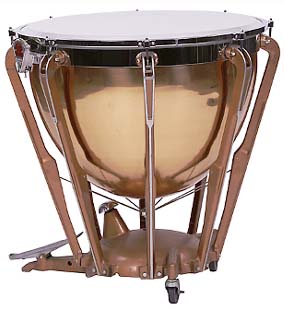Timpani Details
The round head of a timpani can vibrate in a large number of vibrational modes. The fundamental is not generally used in music; it is highly damped and does not produce as pleasing a sound as some other modes. When the head is struck a few inches from the rim, the timpani's fundamental mode is not excited. The player tries to excite the preferred modes 11, 21, 31, 41, 51, 61 . The head is struck about halfway to three quarters of the way out from the center. This is near the nodal line of several of the modes which minimizes their contribution to the sound. The actual sounded frequencies are further affected in a significant way by air damping to finally produce the sequence of frequencies actually heard from the instrument.
By contrast, the snare drum is struck in the center and only excites the 01, 02, 03, modes (Sundberg, The Science of Sounds p91)
The pedal connects to the lugs which control the tension in the membrane. Early timpani had calfskin heads. Modern timpani heads are usually made of mylar.
|
Index
Percussion instruments
Musical instruments |
